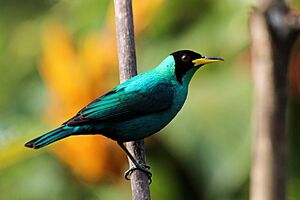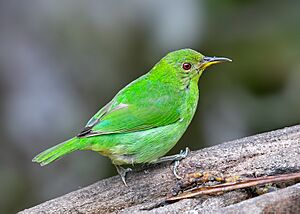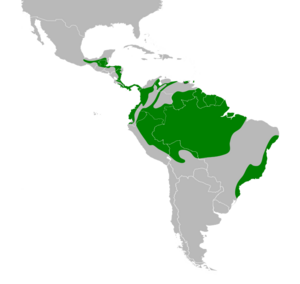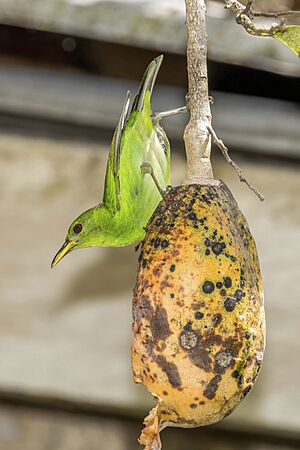Green honeycreeper facts for kids
Quick facts for kids Green honeycreeper |
|
|---|---|
 |
|
| Adult male Green Honeycreeper in Trinidad | |
 |
|
| Female Green Honeycreeper in Costa Rica | |
| Conservation status | |
| Scientific classification | |
 |
|
| Synonyms | |
|
The green honeycreeper (Chlorophanes spiza) is a small, colorful bird. It belongs to the tanager family. You can find it in tropical parts of the New World. This includes areas from southern Mexico all the way south to Brazil. It also lives on the island of Trinidad. This bird is the only species in its group, called Chlorophanes.
Contents
About the Green Honeycreeper's Name
The green honeycreeper was first officially described in 1758. A Swedish scientist named Carl Linnaeus gave it its scientific name. He called it Motacilla spiza at first. The name spiza comes from an old Greek word for a common finch.
Later, in 1853, another scientist named Ludwig Reichenbach created the group Chlorophanes for this bird. The name Chlorophanes comes from two old Greek words. Khlōros means green, and -phanēs means showing. So, its name means "showing green."
Different Types of Green Honeycreepers
There are seven different types, or subspecies, of the green honeycreeper. They live in different parts of its wide range:
- C. s. guatemalensis: Found from southern Mexico to Honduras.
- C. s. argutus: Lives from eastern Honduras to northwestern Colombia.
- C. s. exsul: Found in southwestern Colombia and western Ecuador.
- C. s. subtropicalis: Lives in northern and central Colombia, and western Venezuela.
- C. s. spiza: Found on Trinidad, in eastern Colombia, most of Venezuela, the Guianas, and northern Brazil.
- C. s. caerulescens: Lives from south-central Colombia through eastern Ecuador and Peru, to central Bolivia and western Brazil.
- C. s. axillaris: Found in eastern and southeastern Brazil.
What Green Honeycreepers Look Like
Green honeycreepers are about 13 to 14 centimeters (5 to 5.5 inches) long. They usually weigh around 19 grams (0.7 ounces). They have a long, curved beak.
Male green honeycreepers are mostly a blue-green color. They have a black head and a bright yellow beak. Female green honeycreepers are grass-green. Their throat is a bit lighter green. Females do not have the shiny colors or the black head that males do. Young birds look similar to the females. When they call, it sounds like a sharp chip.
Green Honeycreeper Behavior and Life Cycle
This bird mostly lives high up in the forest canopy, which is the top layer of trees.
Reproduction
The female green honeycreeper builds a small, cup-shaped nest in a tree. She lays two white eggs that have brown spots. She sits on the eggs for about 13 days until they hatch.
What They Eat
Green honeycreepers do not rely on nectar as much as other honeycreepers do. Their main food is fruit and seeds, which make up about 60% of their diet. Nectar is about 20% of what they eat, and insects are about 15%.



